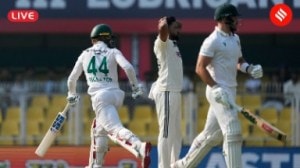A See Change
IT’S quite simple, really! You could say it gets done in the twinkling of an eye. The denim-clad 25-year-old suddenly finds she can...

IT’S quite simple, really! You could say it gets done in the twinkling of an eye. The denim-clad 25-year-old suddenly finds she can’t blink at all. Her eye is clamped open, a few eye drops numb any sensation inside it and then a mechanical arm slides into view. There is a tightening feeling in the eye and then it’s all over in two minutes.
She sallies out confidently into the afternoon sun, with her dark glasses on. ‘‘Of course, I was nervous and I kept hoping it all went well,’’ Vinnie Coutinho says of her experience with LASIK surgery. ‘‘I went to the most eminent eye doctors and opted for this procedure only after double checking.’’ The next morning, she doesn’t have to grope for her thick glasses which she’d been wearing for the last 10 years, and yet can see everything clearly. ‘‘It’s terrific,’’ Coutinho exults.
This was the reaction I got from most patients at the Mehta International Eye Institute in Mumbai. Located in a beautiful 80-year-old bungalow, this Institute offers comprehensive eye care under one roof. From simple eye-tests to hi-tech retinal surgery and glaucoma surgery—it’s all taken care of by the father-and-son team of Dr Keiki Mehta and Dr Cyres Mehta. While Mehta Senior is the inventor of the foldable intraocular lens used widely around the world today and the only Indian member of the International Intraocular Implant Club, Junior has trained in Germany and the US and has worked with stalwarts such as Dr Howard Fine and Dr Dennis Shepard.
LASIK is a procedure which was invented by Trokel and Srinivasan (yes, an Indian) in the US in the early ’80s. Dr Cyres Mehta explains, ‘‘In LASIK (laser assisted in situ keratomileusis), we first make a very fine flap on the surface of the cornea with a machine called a microkeratome. This flap is as thin as a strand of hair. Next, a laser reshapes the cornea. The flap is folded back and reseals instantly. That day, the eye will be red and slightly sore. The next day, the pain is gone and the person is free of spectacles or contact lenses.’’
Dr Mehta has some more LASIK eye-openers:
Who can undergo this procedure?
Anyone with high plus and minus vision upto 12. But diabetics and pregnant women should avoid it. Small children with high cylindrical vision are also good candidates, especially if one eye has a number and the other doesn’t.
Preliminary tests include checking the cornea with a computerised specular microscope to ensure that it is thick and healthy enough for the surgery. The retina is also checked.
Any restrictions?
There are no restrictions even after the surgery. Many Air Force pilots, Marines, and sports champions have undergone this procedure.
And the downsides?
Of the 10 million+ cases internationally, till date visual loss has been reported in less than five. These occurred due to inadequate testing before the procedure.
What are the problems that can develop?
They can be as minor as wrinkles on the flap that need to be smoothed out, a little cleaning to be done under the flap or, in less than 0.001 per cent cases, a minor infection easily treated with antibiotic drops.
Why is it so costly?
The average case costs between Rs 35-50,000. This is because the machines cost Rs 2.5 crore plus. For every case, the blades for the flap-making unit have to be changed. The blades themselves are more than
Rs 10,000 and are imported. Running costs for this procedure are in the range of Rs 20-25,000 per case.
If you feel ready to go ahead with LASIK, here are things you should keep in mind:
Make sure your doctor is LASIK certified. If he is evasive about the outcome, find another doctor.
Make sure topography and computerised specular microscopy and a retinal evaluation are done.
Beware of people who offer to do the procedure for less than Rs 30-35,000. They’re probably excessively reusing the blades.



- 01
- 02
- 03
- 04
- 05




























